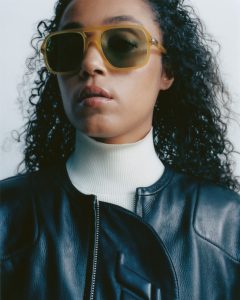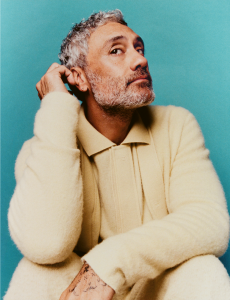Port talks to LA based production designer Marc de Bertier about the challenges of working behind the scenes in the film industry and building new worlds

How did you get into production design?
I discovered production design at university. I wanted to study cinematography or directing, but quickly realised that production design was the best path for me. It’s the first step in the film making process; where words on a page are first transformed into an image. And whereas other departments have to work with existing materials, we have the freedom to create whatever we want.
You might say that they work with images as a base whereas you work with ideas and turn them into images.
Something like that. It’s a discipline that sometimes gets overlooked, because if you’ve done your job properly people shouldn’t notice the work that goes behind it. But the mood and feeling of the story are all conveyed through the design. It’s the space, the environment, that allow the story to be told, they make the audience believe it.

Can you talk a little bit about your design process? Where do you like to start?
It really depends on the film. I like to do world building, so things that aren’t necessarily set in reality; whether it’s completely new worlds, or something that’s slightly off our world. It often starts with the script, and as I read, I picture the story in my mind. If I’m doing something period, I’ll look at references because of course you have to be accurate, but mostly I like to go with my imagination, because in many cases, there’s no right or wrong way for something to look. Not everybody likes this approach, but I think if you find a reference image that exactly matches look you’re going to go for, it’s a problem because that means it’s already been done. So I like to find an image as a base and then draw on it and change it to make it something completely new.
Do you have any references within production design? Any particular designers whose work or career path you look up to?
Dante Ferretti. He’s probably the most well-known production designer. He’s worked on everything, from period films to fantasy; he’s worked with Tim Burton, with Scorsese… and he’s Italian like me! If one day I’m able to do as many different things as he has, I’ll be happy.

What do you think it takes to be so versatile and navigate so many different genres?
I think you need to surround yourself with the right people, because the art department is not a one person job. You need to trust people who have knowledge and craft that you don’t have to do a better job than you. But most of all, you need to want to challenge yourself; not just accept that you’re really good at one thing and do it over and over again.
What’s been your biggest challenge so far?
In terms of scale, it’s definitely been Veil (2017) because we had 13 different sets to dress from scratch and six days of shoot, so two sets a day, at least, on average. With a small crew, I think I rented from 13 prop houses and had the equivalent of four or five 17-foot trucks full of stuff. So that was insane… But from an aesthetic point of view, Calamity Falls (2017) has been the most challenging film yet, because I had to seamlessly marry the 1960s with a large Victorian Mansion. The house and the greenhouse were Victorian, but the film took place in the 1960s so I had to make sure that it looked Victorian, while still feeling like it was the 1960s. Conceptually that was very challenging. Technically, though, Athena (2017) has been one of the most complex and detailed sets I’ve ever had to build. There were lights inside the walls with a lot of plexiglass that turned on and off, and everything had to be custom-made.

You mentioned Veil which recently won a Caucus Award – what attracted you to the project? How did you approach it?
The series was to be set in a post-apocalyptic futuristic world, inspired by Blade Runner, with fog and dirt everywhere, computers that weren’t working anymore… So having my take on what that would look like is what made the project really appealing to me.
How do you take a reference like Blade Runner and detach yourself enough from it to create something new?
Well that’s a hard thing to do. I watched the film once to get a sense of what the director wanted, but you don’t want to be so familiar with the film that you know exactly what each set looks like. You take a couple of elements that you like in a specific frame and, sometimes it’s more a matter of colours. If you really like the colours in a specific scene, you can adapt the palette to a completely different set.

In Blade Runner, the sets almost become their own character. Have you worked on other projects recently where so much was invested in the design?
Well, in Athena, the office was literally a character because it embodied the artificial intelligence. But I also really enjoyed working on the greenhouse in Calamity Falls, because it changes so much throughout the film. At the beginning, it’s just a normal greenhouse, a happy place with lots of flowers and greenery, and then it slowly turns into a room full of carnivorous plants. And then the carnivorous plants die – all except for one that becomes a giant portal to an alternate universe. That set really told the entire story of the film.
Yes, you could really feel the tension of of the film in that greenhouse. How did you build the plant that eats people?
That was built by a specialist: Cleve Hall. He’s a prop fabricator who’s built stuff for huge films. He even had his own TV show about monsters at one point, but now he’s retired. In one of his interviews he said one of his biggest regrets was not doing a human-eating plan, and so we contacted him and he agreed.

And the film is going to be presented at some awards I think?
Yes Calamity Falls is doing very well at awards and festivals all over the world – in Hungary, in London, Italy, Denmark, Canada and the US – and it’s already been picked up for distribution.
And several of those awards are for production design… So what about the future? Is there a particular type of project you’d like to work on?
I really like the look and feel of stop motion animation. I think designers allow themselves to be much more creative in these films, maybe because it’s easier to embrace an entire world on a smaller scale. I also love the aesthetic of German Expressionism, so my dream would be to make a live action film that looks like a stop motion film and takes place in a German Expressionist version of Paris.




